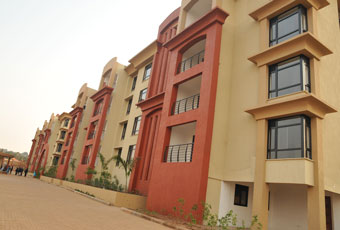
By Eriasa S. Mukiibi
Real estate developers want banks to change mortgage rules
Joseph Kironde’s house in Kansanga, an up-market residential suburb of Kampala, looks somewhat misplaced amid the storied multi-roomed properties behind high wall fences and fancy gates. Kironde’s house is a four-roomed affair, with whitewashed walls, sitting on the edge of a well-kept lawn and no gate. Kironde, 62, is very proud ‘” and lucky, to have it.
Owning a house is the dream of almost every adult Ugandan, especially in urban areas. According to the latest statistics, from the ‘2002 Uganda Population and Housing Census’ only 30 percent of urban dwellers live in houses they own. Up to 58 percent rent and the rent in Uganda is very high.
According to a 2009 report by Knight Frank, one of the top housing managers in the country, rent on a four bedroom executive house in a prime location in Kampala is about US$ 4,500 per month compared to US$ 3,500 for a similar house in Nairobi, Kenya, US$2,500 in Kigali, Rwanda, and US$ 3,000 in Khartoum, Sudan. Only Tanzania, at US$ 6000 per month for a similar house is higher than Uganda.
Only 27 percent rent main house units. The rest rent room type dwellings which go for far less as one heads away from prime locations.
However, the rent is still higher than elsewhere in the region. That is where the desire to own a house starts.
Until recently, private construction of houses, especially residential has been steadily rising, from 8.8 percent of GDP in 2000/1 to 15 percent in 2005/6. It peaked in 2007/8 when the sector grew by 9.1 percent and grew a mere 3.8 percent in 2008/9.
Ugandans traditionally buy plots and personally see through the construction of their houses without ever checking out possibilities for acquiring mortgage.
This method, though derided as archaic by impatient real estate developers who would like to see every income earner rushing to the bank for a mortgage, is not without advantages. One buys the plot and builds at their pace without pressure. The downside is that few people can raise the cash required to put up a house in one swoop.
The build-and-sell section of the housing sector had seen significant growth but the global recession and unreasonably high prices have created a glut over the period. Another problem is that the favored approach of offloading the houses built, through mortgage financing, has yet to gain popularity.
Mortgage products remain obscure, slow to process, and unsuited to the market. Only a small percentage of Ugandans earn a salary. Most are self employed. Yet mortgage lenders target salaried people.
On average, mortgage is serviced at 16% per annum. Using the online calculator used by one of the leading firms in the business, Housing Finance Bank Ltd, for computing monthly mortgage repayments, a client who receives a five-year Shs20 million mortgage at the prevailing mortgage interest rate of 16 percent will have to pay Shs486,361 every month over the ensuing five years. If that sum were to be repaid over 10 years, the monthly figure would be Shs335, 025 and Shs278, 251 if it’s 20 years.
For ten years, from 1999 to 2008, Kironde had to service a mortgage that ate up almost 40 percent of his salary in order to own his house. Every month, he forked out Shs 625,000, having taken out a 45% mortgage on the property. As district engineer, his net monthly income was about Shs1.5 million. He says he was stretched to the limit.
‘I can’t recount the number of times I had to borrow from friends to educate my children and take care of other needs,’ he recalls, ‘mortgage requires sacrifice and discipline.’
Anatoli Kamugisha, the proprietor of real estate firm Akright Projects, spends most of his day scouring top corporations for salary earners like Kironde who are willing to take a mortgage. A pioneer in the business, his hope is to hook them into buying a property in one of his many estates.
His Akright Project works in partnership with three top city banks but Kamugisha blames them for the unpopularity of mortgages.
Usually, the bank mortgage finances only up to 70 percent of the market value of the property in question while the client deposits the balance before signing the mortgage. The bank then pays off the property developer and assumes the task of collecting the money from the mortgagee, with interest and relevant insurance charges.
Banks cannot finance mortgages of 100 percent of the property’s market value because in the event that the mortgagee fails to honor his obligations, the bank would not recover its money and interest even if it sold the property at the market rate. Chances of reselling the repossessed property are even slimmer in a market where demand is on the slide.
Under bank rules, the pre-agreed payment of a mortgage per period has to be paid without fail. But a marketing executive who has sold mortgage for the last eight years told The Independent that it is not unusual for clients to go through problems from time to time.
‘Sometimes a client calls you up to share his fears that he would fail or delay to meet his obligations,’ he says. He adds that most of the time, he has no option but to encourage the mortgagee to look at alternative ways of servicing the mortgage. However, he says none of his clients has had their property repossessed by the bank.
To avoid such crises, a client who gets mortgage automatically has the minimum balance on their savings account raised to the sum required to service the mortgage in one month so that the mortgagee will have at least a month to sort out their finances in case they have problems.
Kamugisha says this process must under go a revolution if property acquisition on credit is to become popular. He says the distress method applied by banks to collect debt from mortgage holders who encounter repayment problems along the way is at the centre of the problem.
‘Every meaningful business must have an innovative problem-solving mechanism,’ he says.
He is unhappy that banks, at times, seem to accelerate the failure of mortgage payments in order to apply distress methods to recover the banks’ money to the utmost discomfort of the mortgagee.
He wants banks to adopt innovative methods of debt collection, including rescheduling repayments, at least thrice, in case a mortgagee encounters problems along the way.
Another option would be allowing a recession period, say for one year, during which a tenant who has failed to meet his mortgage obligations, even after rescheduling thrice, becomes a tenant and the bank takes over the property, but the former mortgagee has first option to buy it back in case his financial position improves during the year.
Build or mortgage
Anyone reading this article to this point must be asking whether it is smarter to build an own house or take out a mortgage.
Kironde says only through a mortgage could he own a house in the posh Kansanga area. But the cheapest housing unit in Akright estates, a three-bedroom iron-roofed house, for example, goes for Shs59 million. Anyone buying it on a mortgage would need to make a down payment of Shs 17,700,000 to Akright if the bank agrees to release the maximum mortgage percentage of 70 percent. If it is a five year mortgage, the client would then be required to pay Shs 1,004,336 per month for the 60 months; in total Shs 60,260,160 to the bank. After five years therefore, the mortgagee would have paid 18,960,160 more than the Shs59 million.
Andrew Semogerere, a building contractor in Gaba, a Kampala suburb, estimates that such a house and the plot would cost Shs 57 million if built about 15 kilometers from the city centre. He favours building over taking a mortgage because, according to him, it gives one control over the process of construction. He says some of the units in the housing estates he has surveyed are poorly constructed and not built to last. What he does not say is that supervising construction works is time-consuming and sometimes stressful if the contractors do not do the right thing and steal the building materials.
 The Independent Uganda: You get the Truth we Pay the Price
The Independent Uganda: You get the Truth we Pay the Price



